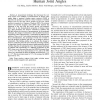Free Online Productivity Tools
i2Speak
i2Symbol
i2OCR
iTex2Img
iWeb2Print
iWeb2Shot
i2Type
iPdf2Split
iPdf2Merge
i2Bopomofo
i2Arabic
i2Style
i2Image
i2PDF
iLatex2Rtf
Sci2ools
TITB
2016
2016
Accuracy Improvement on the Measurement of Human-Joint Angles
—A measurement technique that decreases the root mean square error (RMSE) of measurements of human joint angles using a personal wireless sensor network (WSN) is reported. Its operation is based on virtual rotations of wireless sensors worn by the user, and it focuses on the arm, whose position is measured on 5 degrees of freedom (DOF). The wireless sensors use inertial magnetic units (IMU) that measure the alignment of the arm with the earth’s gravity and magnetic fields. Due to the biomechanical properties of human tissue (e.g., skin’s elasticity), the sensors’ orientation is shifted, and this shift affects the accuracy of measurements. In the proposed technique, the change of orientation is first modeled from linear regressions of data collected from 15 participants at different arm positions. Then, out of 8 body indices measured with dual-energy X-ray absorptiometry, the percentage of body fat is found to have the greatest correlation with the rate of change in sensors’...
Related Content
| Added | 11 Apr 2016 |
| Updated | 11 Apr 2016 |
| Type | Journal |
| Year | 2016 |
| Where | TITB |
| Authors | Dai Meng, Todd Shoepe, Gustavo Vejarano |
Comments (0)

